This page contains links through which we may earn a small commission should you decide to book a tour from our partner.
Top attractions:
Quick Navigation
Unusual Suspects of Schönbrunn Zoo
Life. Life is precious. Each life is precious, yet some creatures are much better at catching the eye than the others. It is often, or rather always, not their fault at all, but the consequences of their adaptation to the environment they live, and evolved to live at. I hope creationists will pardon me for my recent words but, hopefully, if there is one thing where we can meet is an appreciation of various lifeforms. After all, whatever their origins are, each life is precious, right?
I would imagine that most of these unique and strange animals would look absolutely normal in their natural environment, and it would be us, humans, that would feel like we are out of our place. It is certainly not the case in Schönbrunn Zoo. Many of the animals feel out of place despite the hard work done by the staff of the zoo to make them feel like in home, and maybe they do, but, still, some animals look more bizarre than others. I bet you’ll find them not between the lines of the cutest animals in Schönbrunn Zoo but entertaining, nevertheless.
Making this list I understood that most of the strangest animals to me – this is a subjective article after all – are from Central and South America. I’m native to North Europe and I wonder if it is just from my perspective, or there is something to the rainforests of this part of the world that makes it’s inhabitants so bizarre (in a good way)? Maybe, there is a paleontological, or even geological explanation to this, but maybe Moose is a damn strange animal to a Jose from Brazil and Sloth isn’t. You see where I’m going, right? For that reason, one might find some of the animals on the list not as appealing, but I tried to look at this objectively and I sincerely accept your judgement. Anyway, since my list of the top magnificent animals in Schönbrunn Zoo is mainly made of species found in Africa, then I would have to assume that they are simply better at marketing this. Or, maybe it is because Homo Sapiens came out of Africa as well – we’ve been living with these animals since the dawn of our species. Maybe, we have an ancient connection. Who knows. Given all that, ironically, let’s start North.
1. Arctic Wolf
- Status: Vulnerable
- Origins: North Greenland & North America
- Location: The Forest
The Arctic Wolf (Canis lupus arctos), known for its distinctive white fur, is a marvel of adaptation to the extreme cold of the northern regions of North America and Greenland. This species, smaller than its wolf counterparts, features less pointed ears and a shorter snout, traits that distinguish it in appearance and survival capabilities. The Arctic Wolf’s immaculate fur not only camouflages it against the snow to stealthily approach its prey but also provides crucial insulation against the freezing temperatures. These wolves are social animals, living and hunting in packs that follow a strict hierarchy, ensuring the well-being and survival of the group through cooperative efforts.
Despite its status as of least concern, the Arctic Wolf faces challenges from climate change and habitat encroachment, threats that could jeopardize its existence. Historically, in Europe, misconceptions of the wolf as a “bloodthirsty” creature led to significant reductions in their populations. Today, conservation efforts are vital in safeguarding this species, with targeted initiatives aimed at preserving their natural habitats and mitigating the impacts of global warming. These efforts are crucial for maintaining the ecological balance and ensuring the survival of the Arctic Wolf amidst changing environmental conditions.
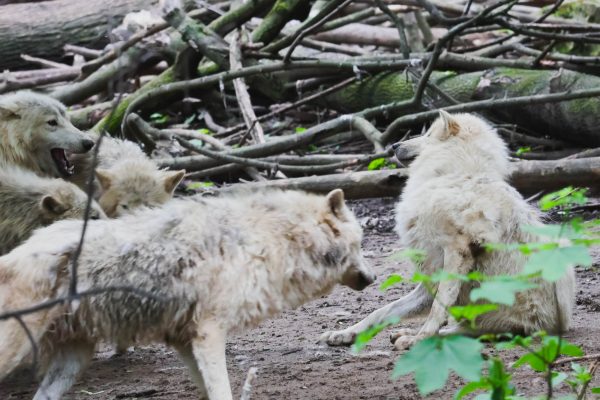

At Schönbrunn Zoo, the Arctic Wolf Haven exemplifies commitment to simulating the natural arctic environment, promoting the display of inherent behaviors among the wolf pack in a setting that closely resembles their wild habitats. This initiative not only allows visitors to observe these majestic animals up close but also plays a crucial role in conservation education. Through interactive exhibits and educational programs, the zoo emphasizes the Arctic Wolf’s adaptation to extreme conditions, their ecological significance, and the urgent need for conservation efforts.
2. Spectacled Bear
- Status: Vulnerable
- Origins: South America
- Location: Near Rainforest House
The Spectacled Bear (Tremarctos ornatus), is distinguished as South America’s only bear species, thriving in a range of environments from rainforests to the bush and grasslands of the Andes at elevations from 250-4,750 m / 820-15,584 ft. This species excels in climbing, frequently foraging in the treetops and choosing to rest in trees at night, either in nests it constructs or in natural tree hollows. It is named for the distinctive light fur markings around its eyes, which extend across the nose bridge and cheeks to the chest, giving it a “spectacled” appearance.
The spectacled bear faces severe threats from habitat destruction due to the expansion of plantations and pasturelands, as well as from illegal hunting, contributing to its status as an endangered species. The lack of protected areas exacerbates these threats. In response, zoos around the globe have initiated an international breeding program aimed at conserving this unique species, highlighting the urgent need for focused conservation efforts.

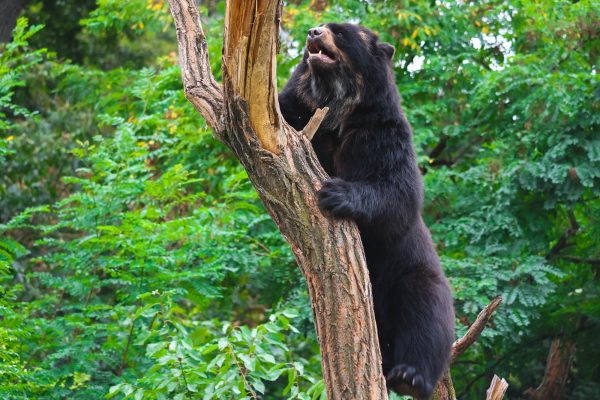

Spectacled bear is the only bear native to South America and a biggest carnivore in the whole continent. Photo by Alis Monte [CC BY-SA 4.0], via Connecting Vienna
At Schönbrunn Zoo, the Spectacled Bear Enclosure is a testament to the commitment to conserving and providing for these majestic animals. Here, the brothers “Sonco” and “Tupa” live, thriving in an environment that closely mimics their natural Andean cloud forest habitat. This setting not only serves as a refuge for brother bears but also functions as an educational platform. Through interactive displays and educational talks, the zoo educates visitors about the ecological significance of the spectacled bear, the challenges it faces in the wild, and the conservation efforts underway.
3. Two-toed Sloth
- Status: Least Concern
- Origins: Rainforests of Central & South America
- Location: Bird House
The Two-toed Sloth (Choloepus), a fascinating species, thrives in the dense canopies of tropical forests, leading a life of leisure and camouflage. Unlike its rapid counterparts in the animal kingdom, this sloth benefits from a unique symbiosis with blue-green algae, which flourishes in its fur, providing it with an effective disguise against predators by mimicking the appearance of lichens. This nocturnal creature, which gets its name from the two distinct claws on each front limb, primarily feasts on a diet of leaves, supplementing it occasionally with fruits and berries. Its slow movements and specialized diet underscore its adaptation to a life spent mostly upside down, navigating the treetops with deliberate care.
Habitat and conservation efforts for the Two-toed Sloth are critical, especially in environments that mimic their natural settings, such as those created at Schönbrunn Zoo. This institution not only provides a sanctuary for these creatures but also plays a pivotal role in educating the public about the significance of tropical forest conservation. By replicating the sloths’ natural habitat, the zoo offers an immersive experience that highlights the sloth’s arboreal lifestyle and dietary habits, further emphasizing the importance of preserving their rainforest homes against threats like deforestation and climate change. Conservation statuses, while currently not alarming, underscore the necessity for ongoing efforts to protect these serene animals and their ecosystems.
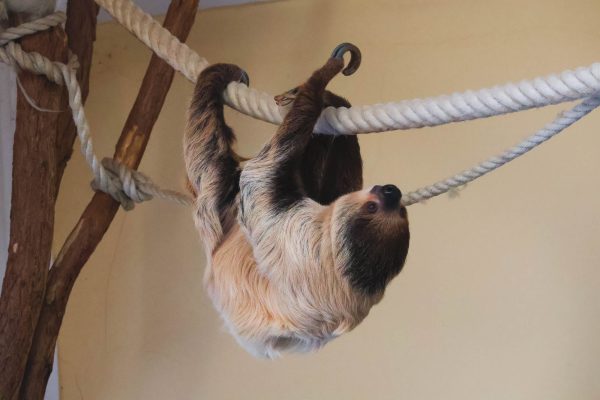

The exhibit at Schönbrunn Zoo serves as a crucial educational platform, illustrating not only the ecological role of the Two-toed Sloth but also the urgent need to protect their habitats. Through interactive displays and informative sessions, visitors gain insights into the challenges these creatures face, including habitat destruction and climate change.
4.Flying Foxes
Malayan Flying Fox
- Status: Near Threatened
- Origins: Southeast Asia
- Location: Rainforest House
The Kalong Fruit Bat, hailing from the lush regions of Southeast Asia, holds the distinction of being one of the world’s largest bat species. These majestic creatures are social animals, living in expansive colonies that demonstrate a remarkable social structure. By day, they can be found hanging upside down in their chosen roosts, often in ancient trees, where an established hierarchy allows the elder males to claim the prime spots for resting.
With the onset of night, these nocturnal beings embark on their quest for sustenance, foraging for fruits, nectar, and pollen. Diverging from their insectivorous cousins who navigate the night through echolocation, Kalong Fruit Bats depend on their acute sense of smell and their proportionately large eyes to find food. This sensory adaptation enables them to thrive in their environment, locating their preferred diet amidst the dense foliage.
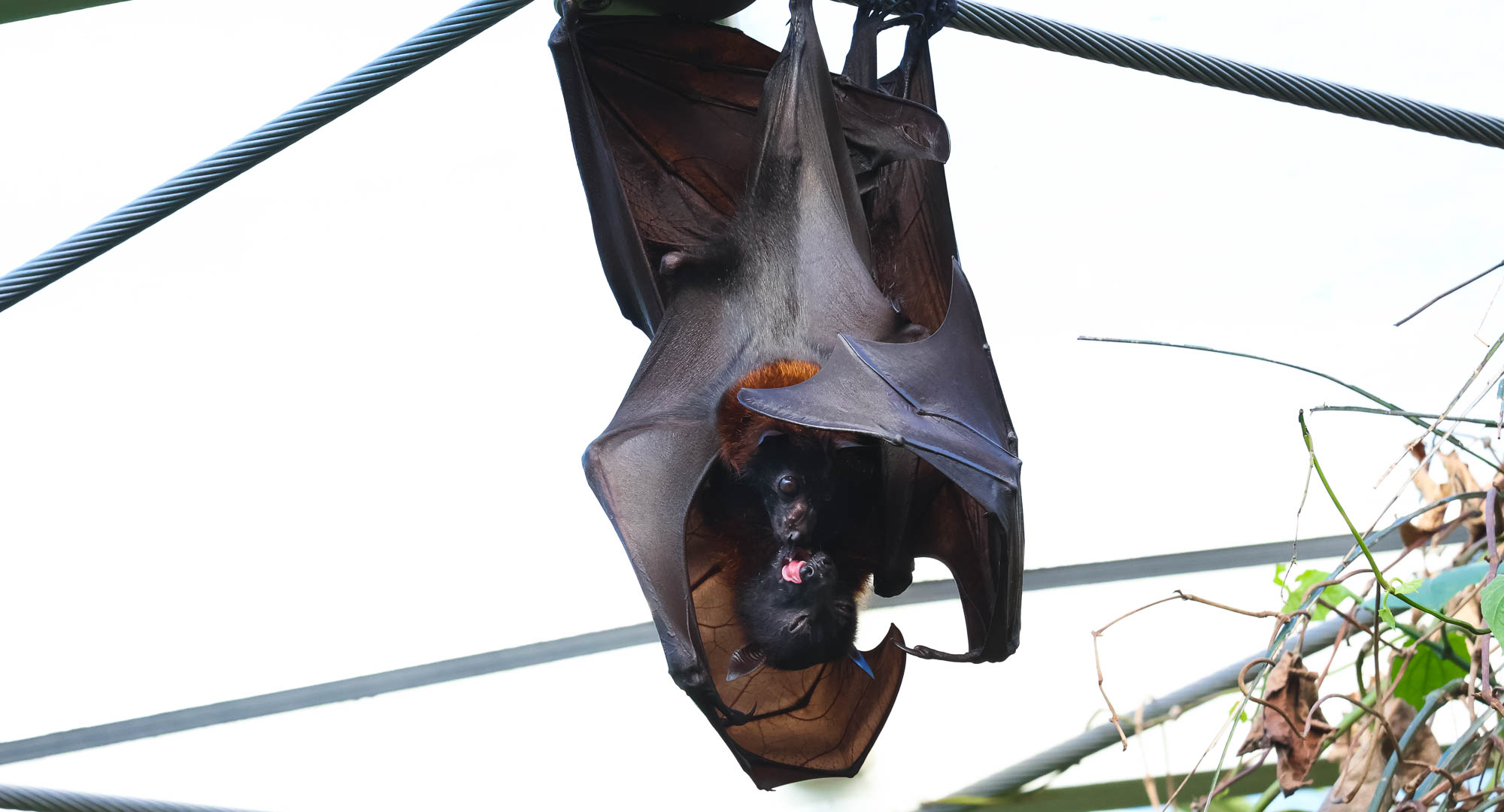
Malayan Flying Fox is one of the two flying fox species living in Schönbrunn Zoo. Photo by Alis Monte [CC BY-SA 4.0], via Connecting the Dots
Indian Flying Fox
- Status: Least Concern
- Origins: Indian Subcontinent
- Location: Rainforest House
The Indian Flying Fox is among the largest bat species in the world. It lives in large colonies. During the day, these bats hang upside down at their resting places in old trees, where a hierarchy often prevails, with older males occupying the best spots.
At nightfall, the flying foxes disperse to search for fruits, nectar, and pollen. Unlike insect-eating bats that are guided by sound, these bats locate their food through a keen sense of smell and their large eyes.
5. Barbary Macaques & Goats
Barbary Macaque
- Status: Endangered
- Origins: Forests of Atlas Mountains
- Location: Near Rainforest House
Barbary macaques are the only macaques found outside of Asia. They are highly adaptable and can live in cold, snowy areas, protected by their dense fur. Their native habitats are the higher forests in the Atlas Mountains of Morocco and Algeria. Additionally, a small group lives on Gibraltar, likely introduced there for hunting purposes.
Barbary macaques stand out as the sole representatives of their kind beyond the Asian continent, showcasing a remarkable adaptability to thrive in chilly, snow-laden environments. This resilience is thanks to their thick fur, which acts as a natural insulator against the elements. They have made their home in the lofty forests of the Atlas Mountains, spanning Morocco and Algeria, displaying a preference for higher altitudes. Intriguingly, a small enclave of these macaques also resides on Gibraltar, a population believed to have been introduced there centuries ago, possibly for sport or as part of exotic pet trade practices.
These sociable primates exhibit a fascinating aspect of their social life through grooming rituals, meticulously cleaning each other to remove parasites while simultaneously forging stronger communal ties. This behavior not only underscores their complex social structures but also their reliance on each other for survival. However, it’s worth noting that over the last quarter-century, the Barbary macaque populations have seen a drastic reduction by half, a worrying trend primarily attributed to loss of habitat. Moreover, the illegal pet trade exacerbates their plight, with juveniles often being taken from their natural surroundings.
During World War II, as Winston Churchill ordered their population in Gibraltar to be replenished, fearing that their loss would signal the fall of the empire because of the popular belief that Gibraltar won’t fall as long as macaques are living there.
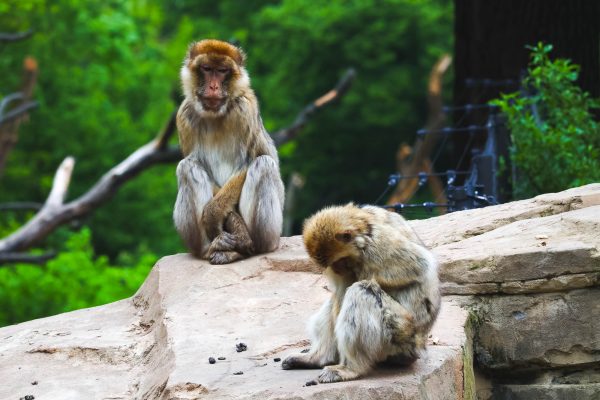
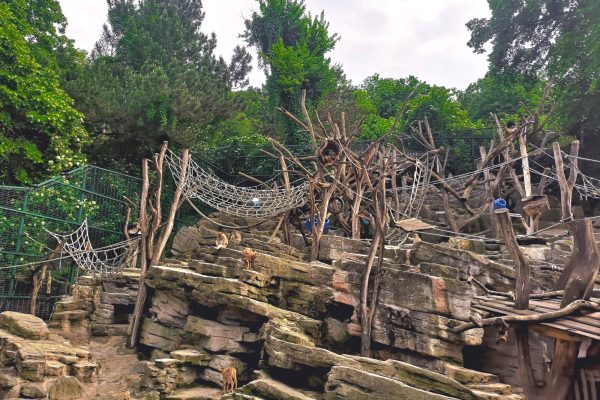
Barbary Sheep
- Status: Vulnerable
- Origins: North Africa
- Location: Near Rainforest House
6. Capybara
- Status: Least Concern
- Origins: South America
- Location: South America Park
The Capybara, known scientifically as Hydrochoerus hydrochaeris, holds the title of the largest living rodent in the world. This remarkable creature derives its name from the Guarani language, translating to “Lord of the Grasses,” a nod to its diet and stature within its natural habitat. These social animals live in structured groups dominated by a single male, alongside several females, establishing territories marked by unique secretions from a scent gland located on their nasal bridge. Their complex social structures and behaviors, including communal grooming and synchronized swimming, play a crucial role in the dynamics of their ecosystems.
Capybaras thrive in semi-aquatic environments, primarily found across South America’s wetlands, rivers, and lakes. These habitats are crucial not only for the survival of the Capybara but also for maintaining the ecological balance, as they act as both prey and ecosystem engineers. However, their existence is threatened by habitat loss and fragmentation, which underscores the importance of conservation efforts to protect these vital wetlands. The Schönbrunn Zoo’s exhibit, mirroring the lush wetlands of South America, serves as an educational platform to highlight the Capybara’s natural behaviors and the significance of wetland conservation for biodiversity.
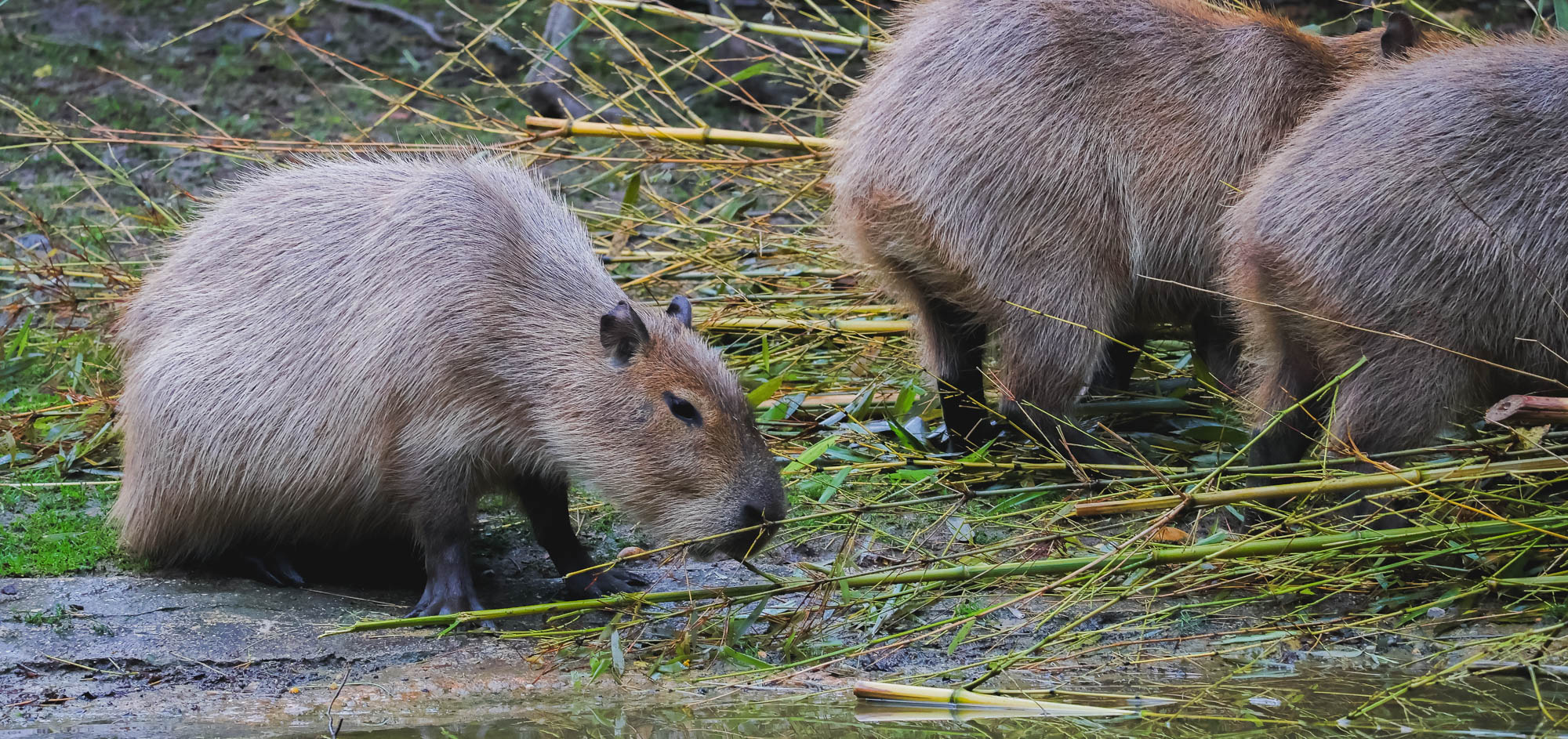
Capybara is the biggest rodent in the World. Photo by Alis Monte [CC BY-SA 4.0], via Connecting the Dots
The exhibit at the Schönbrunn Zoo offers visitors an immersive journey into the world of Capybaras, emulating their natural, semi-aquatic habitats to promote conservation awareness. Through the design of the exhibit, which includes water bodies for swimming and vegetation for grazing, the zoo underscores its dedication to providing environments that allow Capybaras to engage in their natural behaviors. The setup not only enlightens visitors about the Capybaras’ social dynamics and dietary habits but also serves as a testament to the zoo’s commitment to conservation education. By emphasizing the importance of wetland ecosystems and the threats they face, the exhibit plays a pivotal role in fostering an appreciation for the natural world and the necessity of habitat protection.
7. Northern Rock-hopper Penguin
- Status: Endangered
- Origins: Islands of South Ocean
- Location: Polarium
The Northern Rockhopper Penguin (Eudyptes moseleyi) is a species distinguished by its spectacular and unusual appearance, characterized by unique yellow plumes that set it apart from its counterparts. Adapted to the cold, this species thrives in the rugged, remote sub-Antarctic islands, showcasing nature’s remarkable ability to evolve and specialize. Despite their charismatic presence and adaptation to their natural habitats, Northern Rockhopper Penguins face significant challenges. Threatened by climate change, overfishing, and habitat destruction, their status as endangered highlights the pressing need for concerted conservation efforts to safeguard their future.
Their natural habitat, a testament to the harsh yet fascinating sub-Antarctic ecosystem, consists of cool, rocky shores that provide not only the necessary conditions for their survival but also a stunning backdrop to their unique behavioral patterns. Conservation efforts for these penguins are critical, focusing on protecting their breeding sites from the impacts of global warming and addressing the decreasing availability of primary food sources due to overfishing. These efforts are essential in mitigating the threats facing Northern Rockhopper Penguins, ensuring their survival amidst the changing global environmental landscape.

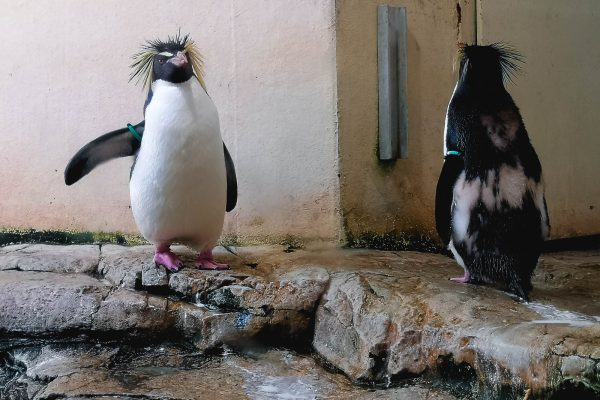
The Schönbrunn Zoo’s dedicated Northern Rockhopper Penguin exhibit is a beacon of conservation and education. Since 1993, the zoo has successfully created a specialized habitat that closely mimics the penguins’ natural environment, marking a significant achievement in captive breeding and conservation. This exhibit provides an immersive experience into the lives of these penguins and serves not only as a captivating attraction but also as an educational platform. It raises awareness about the challenges these endangered species face and the importance of global conservation efforts. Through interactive displays and informative signage, the zoo plays a pivotal role in fostering a deeper understanding and appreciation for the intricacies of marine ecosystems and the urgent need for conservation action.
8. White-nosed Coati
- Status: Least Concern
- Origins: Central America
- Location: Between Rainforest House & Polar Bear World
The White-nosed Coati (Nasua narica), named for its distinctive movable, trunk-like elongated nose, is a fascinating species native to the Americas. These diurnal mammals are known for their sociable nature, living in fixed “residential districts” that span diverse environments—from lowland rainforests to semi-deserts and bush areas, and even rocky landscapes with thickets up to 2,500 meters (approximately 8,202 feet) in altitude. Their omnivorous diet and adaptability to various habitats underscore their resilience. However, in some parts of their range, White-nosed Coatis face threats from hunting for their meat, highlighting the need for awareness and conservation efforts to ensure their survival.
Their habitat and conservation status are of significant interest, as the White-nosed Coati, while currently listed as of least concern, faces challenges from habitat loss and fragmentation. These animals thrive in a range of environments that include dense forest canopies for climbing and ground cover for foraging, which reflects their versatile feeding habits that span fruits, insects, and small vertebrates. The conservation of their habitats is crucial not only for the survival of the species but also for maintaining the biodiversity and ecological balance of their environments. Efforts to protect and preserve these habitats are essential for the coatis’ continued presence in the wild.

White-nosed Coati is native to the New World from Argentina to Arizona. Photo by Alis Monte [CC BY-SA 4.0], via Connecting the Dots
At Schönbrunn Zoo, the White-nosed Coati enclosure, home to individuals like “Fernando,” “Puppi,” “Caesar,” “Carmen,” “Diego,” and “Daria,” provides an enchanting insight into the lives of these adaptable mammals. The zoo’s dedicated habitat mimics their natural forest environments, complete with trees and varied ground cover to encourage natural behaviors such as climbing and foraging. This setup not only offers zoo visitors a glimpse into the coatis’ daily lives and social structures but also serves as an educational platform to raise awareness about the species’ ecological roles, adaptability, and the conservation challenges they face. Through such initiatives, Schönbrunn Zoo emphasizes the importance of wildlife conservation and the need for human engagement in protecting natural habitats, ensuring that the White-nosed Coati continues to thrive both in captivity and in the wild.
9. Giant Anteater
- Status: Vulnerable
- Origins: South America
- Location: South America Park
The Giant Anteater, a unique creature native to South America, leads a solitary existence, primarily active during daylight hours. This strictly terrestrial mammal is renowned for its diet that predominantly consists of ants, termites, and beetle larvae. Remarkably, it consumes these insects without causing destruction to their nests, showcasing a fascinating balance within the ecosystem. The Giant Anteater’s distinct appearance, characterized by its long, bushy tail and formidable claws, plays a crucial role in its feeding habits, especially in breaking into termite mounds to access its prey.
Habitat destruction, wildfires, and hunting have placed the Giant Anteater in a vulnerable position, making conservation efforts critical. Its natural habitats span diverse ecosystems, including savannas, swamps, forests, and thornbush steppes across South America. Recognizing the urgent need for conservation, Schönbrunn Zoo has taken a proactive stance by participating in the European Endangered Species Programme (EEP). The zoo’s initiatives are aimed at safeguarding these magnificent creatures and their habitats from further decline, highlighting the importance of preserving biodiversity and the natural environments that sustain it.

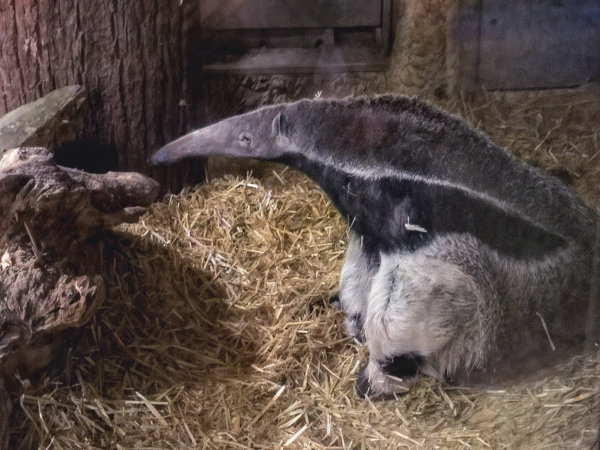
Schönbrunn Zoo’s Giant Anteater exhibit exemplifies cutting-edge conservation and education. Meticulously designed to mirror the natural habitats of these animals, it offers an immersive experience into their lives, emphasizing the zoo’s commitment to educating the public on wildlife conservation. Interactive displays and educational panels within the exhibit delve into the giant anteater’s diet, habitat, and the conservation challenges they face, such as critical habitat loss. This approach not only enhances public understanding and appreciation of Giant Anteaters but also highlights the significance of global conservation efforts, inviting visitors to support the preservation of biodiversity and natural habitats.
10. Bennett’s Tree-kangaroo
- Status: Least Concern
- Origins: Tropical Rainforest in Australia
- Location: Behind Koala House
Bennett’s Tree-kangaroos, distinct from Bennett’s wallabies mentioned in the provided texts, are fascinating marsupials native to the lush rainforests of Queensland, Australia. They are adept at an arboreal lifestyle, with powerful limbs and a long tail that aids in navigating the dense canopy. Unlike their ground-dwelling counterparts, Bennett’s Tree-kangaroos spend most of their time in trees, showcasing remarkable adaptations for their elevated habitat. They feed on a diet comprising leaves, fruits, and flowers, reflecting their role in the ecosystem as browsers of the forest canopy.
The natural habitat of Bennett’s Tree-kangaroos is under increasing threat from habitat destruction and climate change, highlighting the urgent need for conservation efforts. These marsupials inhabit areas that are rapidly diminishing, making their conservation a priority for ensuring their survival. Protected areas and conservation programs are vital in safeguarding the remaining habitats, ensuring that Bennett’s Tree-kangaroos continue to thrive in their natural environment. Their status, while currently classified as of least concern, necessitates ongoing monitoring and preservation actions to counteract the adverse effects of human activities and environmental changes.
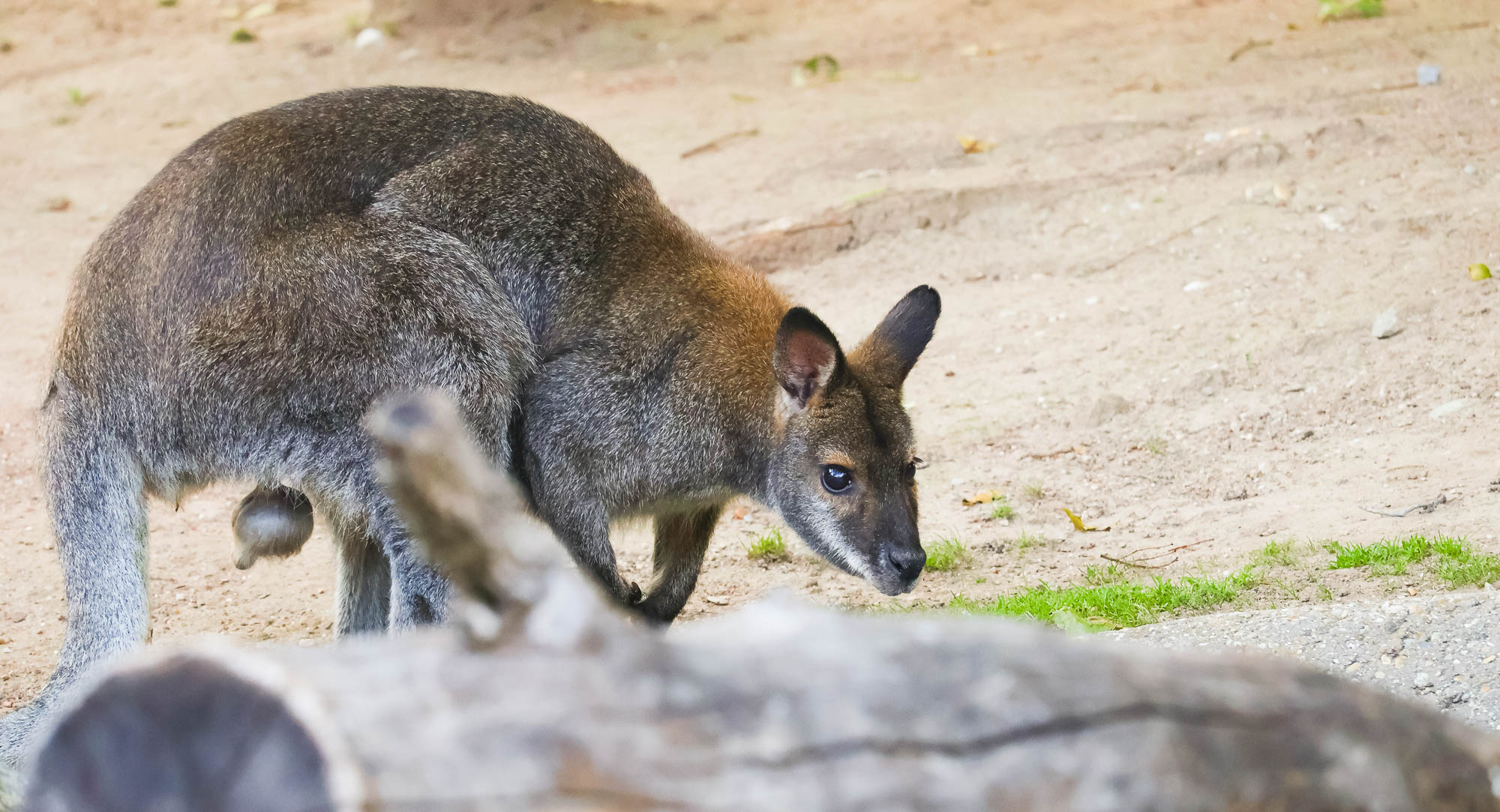
A purse made of kangaroo’s balls is a popular souvenir from Australia. Photo by Alis Monte [CC BY-SA 4.0], via Connecting Vienna
At Schönbrunn Zoo, the Bennett’s Tree-kangaroo exhibit is a testament to the zoo’s commitment to conservation and education. Designed to closely replicate the dense canopy environment of Queensland’s rainforests, the exhibit features towering trees and lush foliage, providing visitors with a window into the arboreal life of these marsupials. The zoo’s efforts extend beyond the exhibit, serving as an educational resource that highlights the unique biodiversity of Australia’s rainforests and the critical conservation efforts needed to preserve them. Through engaging informational panels and interactive displays, the zoo fosters awareness and appreciation for Bennett’s Tree-kangaroos and underscores the importance of global conservation efforts in maintaining the planet’s biodiversity.
Map of Schönbrunn Zoo
Schönbrunn Zoo is located to the east of Hietzing (13th), to the south of Penzing (14th) and to the west of Meidling (12th). The 10 strangest animals are marked in purple: